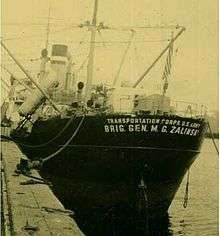USAT Brigadier General M. G. Zalinski
 | |
| History | |
|---|---|
| Name: |
|
| Builder: | American Ship Building Company, Lorain, Ohio |
| Yard number: | 765 |
| Launched: | 1919 |
| Out of service: | 1946 |
| Fate: | Sunk in storm, 26 September 1946 |
| General characteristics | |
| Type: | Cargo ship |
| Tonnage: | 2,600 GT |
| Length: | 251 ft (77 m) |
| Beam: | 44 ft (13 m) |
| Depth: | 26 ft (7.9 m) |
USAT Brigadier General M. G. Zalinski was a U.S. Army transport ship that served in World War II. It sank in 1946 in the Grenville Channel in British Columbia's Inside Passage.[1][2] The crew were rescued by a tug boat and the SS Catala passenger steamer, but the cargo of bombs and oil went down with the ship. As of June 2006, planning is underway by Canadian officials to deal with the wreck, located near the site of the ferry MV Queen of the North which sank on 22 March 2006.
Ship history
The ship was built as the Lake Frohna (hull number 765) at the American Ship Building Company in Lorain, Ohio as a cargo vessel for the United States Shipping Board, and was delivered in June 1919.[3] In 1924, she was sold to the Ace Steamship Company and renamed Ace. She changed hands again in 1930, being sold to the Terminals & Transportation Corporation of Duluth. Finally, in 1941, she became the Brigadier General M. G. Zalinski in the employ of the U.S. War Department.[4]
Sinking
On 26 September 1946 the Zalinski was en route from Seattle to Whittier, Alaska, with a cargo of army supplies when she ran into the rocks of Pitt Island in the Grenville Channel, 55 miles south of Prince Rupert. The ship sank within twenty minutes, while her crew of 48 were rescued by the tug Sally N and the passenger steamer SS Catala. According to a report in The Vancouver Sun of 30 September 1946, at the time of her sinking she was transporting a cargo of at least twelve 500-pound (230 kg) bombs, large amounts of .30 and .50 caliber ammunition, at least 700 tonnes of bunker oil, and truck axles with army type tires.[5]
Discovery
On 20 September 2003, the United States Coast Guard Cutter Maple reported an oil slick off Lowe Inlet. It was investigated by the Canadian Coast Guard Ship Tanu three days later, which obtained oil samples, but was unable to discover the source. In early October 2003, a commercial airline pilot reported further pollution. The Canadian Coast Guard confirmed the presence of the slick, and discovered that some three miles of shoreline had been affected. Again, no source was found, and the Coast Guard suspected that the oil could be surfacing from an old wreck.[4]
On 30 October 2003 a survey by a remote control underwater vehicle located the wreck at 53°31.308′N 129°34.774′W / 53.521800°N 129.579567°WCoordinates: 53°31.308′N 129°34.774′W / 53.521800°N 129.579567°W. By mid-November, divers had been sent down twice to plug leaks in the hull. When investigations revealed that the ship was the Brigadier General M.G. Zalinski, and contained munitions, all operations were halted until an assessment was completed and the site declared safe. In January 2004 a warning was issued ordering mariners to avoid anchoring or fishing within 200 metres (660 ft) of the wreck, which is about 27 metres (89 ft) below the surface. The Canadian government is currently developing a plan to remove all the oil and munitions.[4]
Cleanup
The vessel has been leaking oil for some time.[1][2] In May 2012 the Vancouver Sun and Globe and Mail reported that new concerns over leaking oil have triggered emergency plans to deal with the leaking oil. In July 2013 the Canadian government announced a "significant environmental protection operation" to clean up the wreck site. [6]
However, by December 4, 2013 only 35 tons of fuel oil was recovered; Environmental Protection Operation came to the end and Brigadier General M. G. Zalinski was declared free of oil and safe for environment.
References
- 1 2 Larry Pynn (2012-05-02). "Natives on B.C. coast haunted by threat from sunken Second World War ship". Vancouver Sun. Retrieved 2012-05-03.
The U.S. transport ship, Brigadier General M.G. Zalinski, is thought to have carried 700 tonnes of bunker fuel and at least a dozen 227-kilogram bombs when it ran aground in 1946 and sank in Grenville Channel, about 40 kilometres northwest of Hartley Bay.
mirror - 1 2 Wendy Stueck (2012-05-02). "Coast Guard to hire divers to patch and inspect wreck off B.C. Coast". Globe and Mail. Retrieved 2012-05-03.
The work will be ordered on an “urgent” basis, reflecting concerns that the ship – the U.S. Army’s Brigadier-General M.S. Zalinski, which sank south of Prince Rupert in 1946 – is leaking fuel and that the amount could increase, a Coast Guard spokesman said.
mirror - ↑ "The American Ship Building Company, Lorain, Ohio". shipbuildinghistory.com. Retrieved 27 May 2010.
- 1 2 3 "Zalinski". oceanecology.ca. Retrieved 27 May 2010.
- ↑ "Wreck filled with oil and bombs". canada.com. Retrieved 27 May 2010.
- ↑ "Canadian Coast Guard Announces Significant Environmental Protection Operation". dfo-mpo.gc.ca. Retrieved 3 Aug 2013.
- Boswell, Randy; CanWest News Service (2006-06-02). "Storms pull legendary ship's skeleton from beach grave". The Province. Retrieved 2007-11-03.
